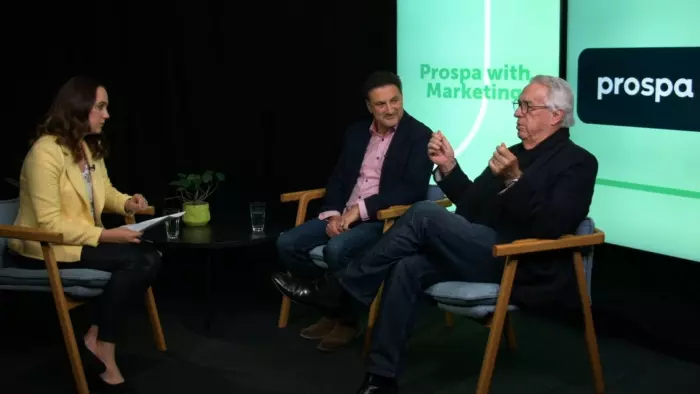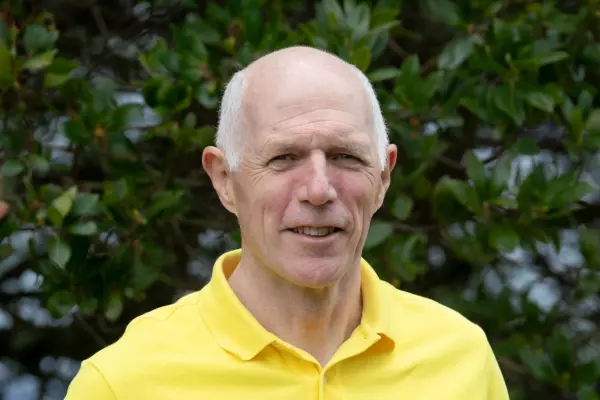A small business that has a separate marketing department is like “a church having a religion department – it’s crazy”, says Mike Hutcheson, creative consultant and ex-CEO at Saatchi and Saatchi.
He said a business has two functions – marketing and innovation – and that everything else is a cost.
“To me, a business is really all about marketing.”
Hutcheson was part of the panel for BusinessDesk and small lending specialist Prospa’s second webinar on how small businesses can do marketing better.
BusinessDesk investments editor Frances Cook, the host, and Quantum Jump chief executive Ben Goodale completed the panel.
Two weeks ago, during the first webinar that you can watch here, HR issues around small businesses were discussed.
This three-part webinar series follows a survey carried out by Prospa earlier this year on small business owners in New Zealand to get an idea of what was keeping them up at night. Issues with marketing and where to invest limited dollars were high on that list.
Hutcheson explained that marketing was about building a business to answer a consumer’s need.
He told Cook he wasn’t surprised the Prospa survey found 35% of small business owners said marketing to attract new customers was the top internal barrier to achieving their goals.
“If a business is totally product focused, you know, push rather than pull, it’s going to struggle. You need to figure out if there is a need first and then answer that particular need.”
Push vs pull
Hutcheson said that push vs pull meant that you as a business owner were assuming a customer needed your product, as opposed to what it was they needed.
He said there were three relevant circles when marketing a product:
- What you’re good at.
- What you love doing.
- And what the customer needs.
“Where those circles intersect is the sweet spot.
“You’ve got to make sure there’s a market in the gap. You need to think is what I’m doing and what I’m passionate about, something that has a purpose and answers a need,” Hutcheson said.
Goodale, in turn, said social media was one of the best marketing tools for small businesses because “it’s cheap, easy to access and it doesn’t rely on a lot of investment”.
“The tools on Facebook and Instagram are sensational for someone who really doesn’t have a large degree of knowledge … That’s a very accessible way for people to get in,” Goodale said.
He did, however, warn that every great marketing campaign needed a great story and should "convey it in an effective way”.
Another example Goodale suggested was the use of paid searches that allow businesses to advertise within sponsored listings of search engines.
And lastly, he said another cost-effective marketing tool was to grow and maintain a database of customers, with email addresses.
Social media
Cook wanted to know whether a small business should aim to market its products across all the channels of social media, or just the bigger and best-known ones.
Goodale said it depended on your target audience, because each channel had its own niche audience. He said TikTok was a great platform for targeting teenagers and people in their 20s, but Facebook was a great platform for an older audience.
“It all comes back to what are you selling. Who is the audience for that? Then pick the right social media because it’s very unlikely you’ll need to be in all of them.
“You have to manage your time and decipher: where is your time best spent?”
He said small business owners were far too busy to do everything, so they needed to pick and choose.
Cook wanted to know how a small business could understand its customers better and what they needed from them.
Hutcheson responded by saying that times have changed a lot since the 1970s when it was easy to reach the entire country due to there being only a handful of media channels. He said: “Now, there is just such a multiplication of different media.”
Hutcheson reiterated Goodale's points by adding it was very important for you to know your target audience based on:
- Who is your audience?
- What are they watching?
- When are they watching it?
- And how do they pick what they’re watching?
“In the old days, of course, it was ‘carpet bombing’. It was like World War 2, you had to kill everybody to get the ones you wanted. It got more sophisticated due to direct marketing in the 70s, 80s and 90s.
“And now, with the plethora of channels available we do ‘carpet bombing’ by social media. To me, now, the delete button on my computer is most likely the most used button because people are ‘carpet bombing’ me with stuff because they haven’t thought it through,” Hutcheson said.
However, Hutcheson said the best form of advertising remained word of mouth. The one thing that remained constant in any form of marketing was storytelling.
“You’ve got to tell stories in a much briefer form. One of the things we do a lot of in advertising is condensing long copy to short.
“You have to think down to the minimal, meaningful message that you can make and then figure which mediums to actually put it out on,” he said.
Watch the video below for the full webinar:
Prospa’s Line of Credit has now launched to offer a convenient and flexible source of funds of up to $150,000 over a 24-month term.
The new product is the perfect solution for small businesses seeking to cover cashflow gaps that may occur unexpectedly. The ongoing access to funds allows business owners to draw down on the Line of Credit so they can pay staff, buy stock, or manage late payments.
The loans have a renewable 24-month term, with interest-only paid when the funds are used by the business. The application process takes as little as 10 minutes, with fast decisions to make funding available within 24 hours of approval.
If you want to learn more about Prospa’s Line of Credit visit https://www.prospa.co.nz/.















